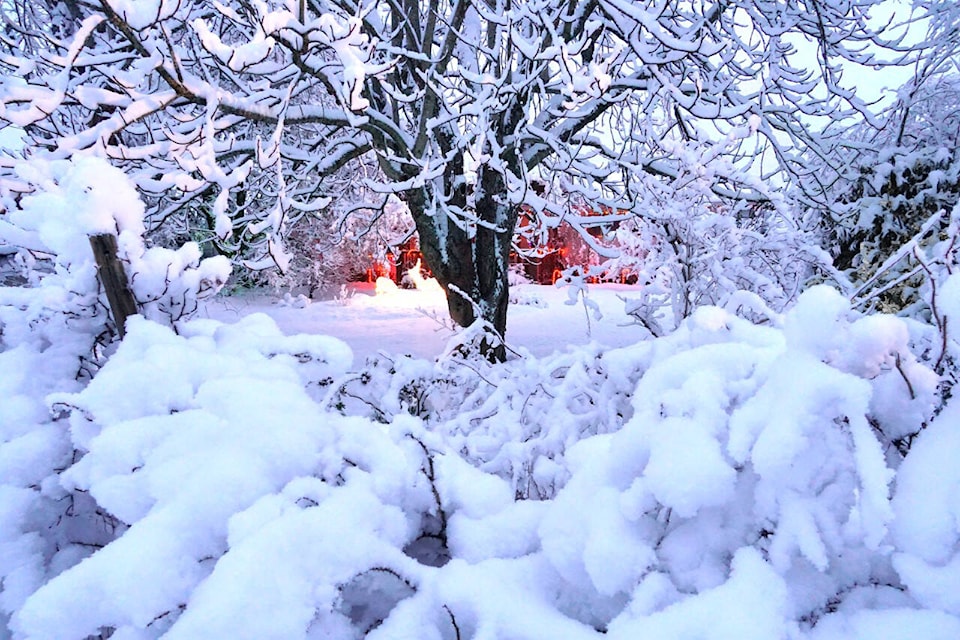By Leslie Cox
Special to the Record
I came across an article on how to have structure, colour, and even flowers in your garden in winter. Humph. Looking out at our garden all I can see are piles of snow.
Those first two snowfalls left 15.5 inches (40 cm) behind in our area and the negative temperatures that followed turned the landscape into a sheet of ice. Not good for a garden, especially when the snow had laid many lower shrub branches on, or almost on the ground. If you can even see what is happening under the snow, that is.
However, when I can see my six-to-seven-foot-tall (1.8 – 2 m) old-fashioned Weigela florida reduced to roughly three feet (0.9 m) with its snow load, I can envision what is happening to my other shrubs.
John’s lovely yellow tree peony, a gift from an elderly neighbour’s garden before she moved, is also hunched over, in spite of John knocking the snow off at the earliest opportunity.
Turning my eyes from the snow garden back to the article on winter beauty in the garden, I thought what’s the point? But that is not to say we do not have some winter delights in our combined landscape.
I have two Skimmia japonica shrubs, a male and female, in the front, and this time of year the female is resplendent with its red berries. Very much like holly berries but without the spiny leaves. (OK, I do know there are smooth-leaved holly varieties, too!)
Although the berry display is a little lacking so far this winter, I can look forward to the spring fragrance of the male skimmia flowers. A more powerful, and delightful scent than the female flowers in my opinion.
Flowers I can enjoy in the winter are my hardy cyclamen coums. An incredibly small plant that somehow manages to thrust its dainty, lilac-pink-coloured blossoms above the snowline on ridiculously weak-looking stems. Goes to show, appearances do not always reveal inner strength.
Another delightfully scented plant for the winter garden is Viburnum x bodnantense. (You might know it under its common name: arrowwood.) We have the cultivar ‘Dawn’ in the back garden, which is purported to start blooming in late autumn through into spring in the Pacific Northwest. But John has placed his up against the cedar hedge, in deep shade, so it often does not open its flowers until late December or early January, depending on the temperature. (If you are looking for this viburnum in nurseries, it is sometimes called ‘Pink Dawn’.)
Jasminum nudiflorum, or winter jasmine, was also mentioned in the article. We do not have this plant but I think I should consider it for my garden as it is hardy to Zone 6. I know the fragrance is amazing. (Another item on my 2023 plant wish list.)
Wintersweet, or Chimonanthus praecox, was also noted but at 10 feet tall (3 m) with a multi-stemmed, fountain shape I fear it might not handle much of a snow load. Never mind that it is borderline hardy for our garden zone. But the honey scent sounds heavenly.
And then there are the Christmas roses… the hellebores. With all the wonderful cultivars on the market now, one can develop a stunning floral display for their winter landscape. I certainly cherish ‘Ivory Prince’ and ‘Pink Frost’, gifts from my mom years ago and cherished reminders.
And I will cherish the memory of my dad, my childhood gardening teacher, now gone these 10 years come Boxing Day, as I gaze out at our winter garden.
From our garden to yours, John, Sadie and I wish you a festive holiday season!
Leslie Cox co-owns Growing Concern Cottage Garden in Black Creek. Her website is www.duchessofdirt.ca.
DUCHESS OF DIRT: Brown marmorated stink bugs have reached the Comox Valley – now what?
